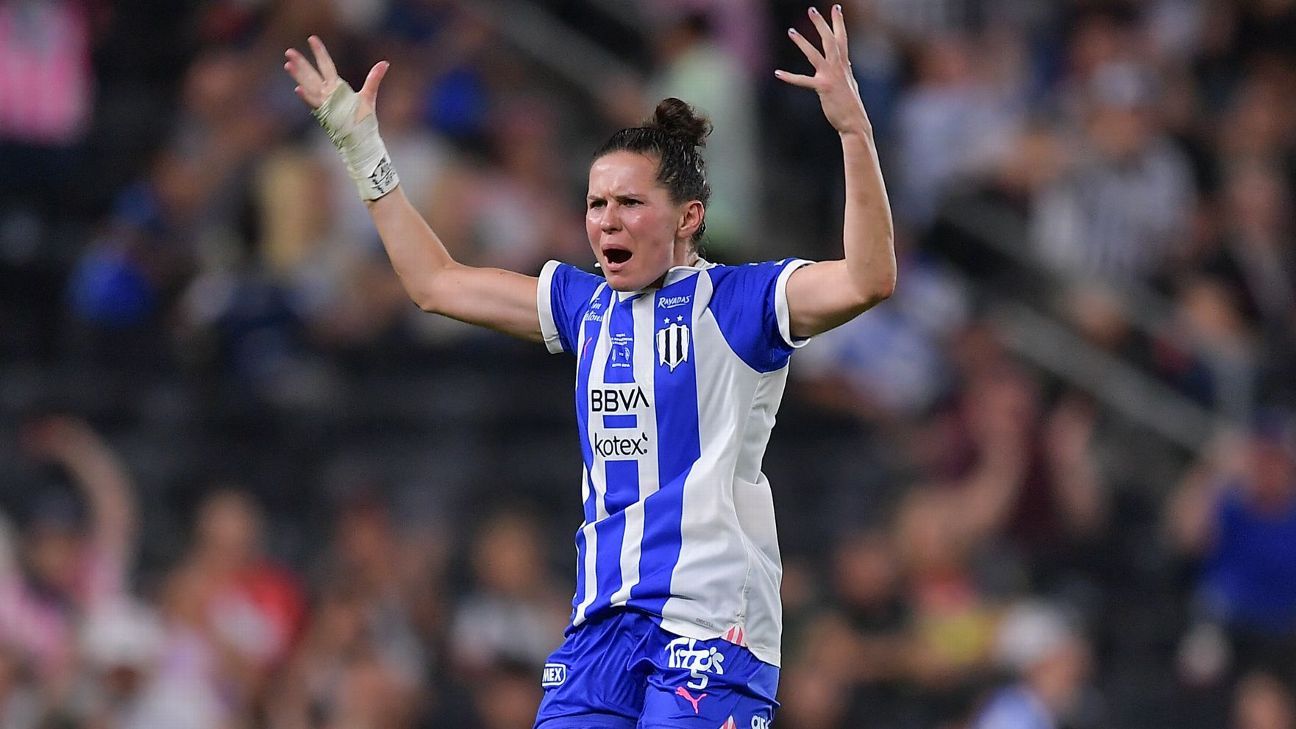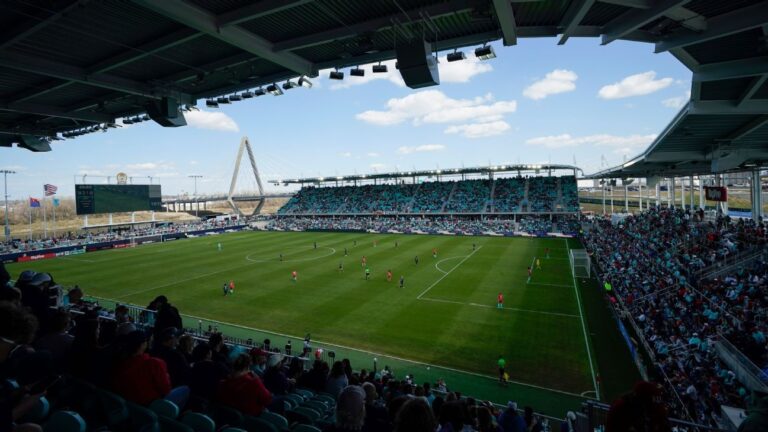Merel van Dongen has recently faced a lingering question from her Netherlands international teammates: Why move to Mexico’s Liga MX Femenil?
“They always say I want to end my career,” the 2019 World Cup runner-up, who signed with Monterrey (commonly known as Rayadas) on loan from Atlético Madrid in January, tells ESPN. “I don’t see any reason why you shouldn’t play in Mexico.”
Editor’s Picks
2 Related
On paper, it’s fair to question. Why would an elite defender, aged 31, leave the noteworthy competitiveness of the European club scene to join a young Latin American league that was founded in 2017? But for the many high-profile players that have had their heads turned by Liga MX Femenil, there’s a growing recognition that Mexico offers an intriguing and burgeoning competition.
“We have a very interesting league, one that’s growing extremely fast,” Van Dongen adds. “I think that if you look at the growth in the last five years, I think there’s no league in the world growing as much as the one in Mexico.”
Can it grow to rival the NWSL? Improvements must still be made, none more so than to achieve greater depth to the competition, but the potential is there.
“There’s something going on in Mexico,” says South Africa international Thembi Kgatlana, 2018’s CAF Women’s Player of the Year, who signed with Tigres from Racing Louisville in December. “You see players like Jenni [Hermoso] have been here for a long time, Merel joined, I joined, Jermaine [Seoposenwe] has been here, you see Sandra Paños from Barcelona coming down here.”
Merel van Dongen joined Monterrey at the start of 2024. Azael Rodriguez/Getty Images
How Mexico’s Liga MX Femenil grew from small beginnings
When Liga MX Femenil began in 2017, financed by the men’s Liga MX teams that fall under the same ownership umbrella, it did so with questions about roster rules that had constructive but misguided intentions.
Seeking to provide a platform for the next generation, clubs only allowed Mexican-born players and two spots per roster for those over the age of 23. Doing so not only limited veterans, but also those who had Mexican citizenship who were born outside of the country.
“I played on the Mexico national team since I was 15, but I wasn’t allowed to play in the league because I wasn’t born in Mexico,” Janelly Farias, a defender for FC Juarez, tells ESPN. “[The] rule just didn’t make sense, right? Because how can I represent my country, but not the league?”
Liga MX Femenil has swiftly reshaped and formed into a competition that has brought in marquee names from abroad that are just as spectacular as matches that can showcase 50,000+ fans.
Regulations were first relaxed by 2019 to remove the age limit and allow any player with Mexican citizenship, regardless of where they were born, to play in the league.
Then came a watershed moment in the summer of 2021 when foreign players were introduced.
“A lot of things have grown,” Farias says. “They finally allowed foreign players. We started with two per team and now we’re at five per team. That’s made the league much more competitive.”
Attracting players from the NCAA
Before Van Dongen and Kgatlana, one of Liga MX Femenil’s first foreign stars was United States youth international Mia Fishel, who has gone on to represent the senior USWNT and is now playing for Chelsea.
Instead of joining the NWSL through an entry draft, Fishel opted to sign with Tigres in January of 2022. Won over by the large crowds in a soccer-hungry country and the opportunity to become an immediate starter, Fishel thrived, eventually claiming an Apertura title and Golden Boot award in her second season.
“If more players are going to be recognized, like Tigres recognized me, [the] players are going to come here,” Fishel told ESPN in 2022, one year before she would earn her move to England.
Other NCAA players have also taken notice of opportunities south of the border.
“When I was younger, I didn’t want to come play over here … but as time went on, I thought, it’s really growing,” says Michelle Gonzalez, a two-time NCAA DII All-American who joined Pumas earlier this year after college. “Everyone’s good here, everyone’s strong and has good technique.”
Pumas teammate Sindia “Cindy” Arteaga, who played NCAA soccer at Cal State Northridge and also went pro through Mexico, noted her preference for the Liga MX Femenil’s style of play over the NWSL.
“I wouldn’t really fit into the NWSL,” she says. “It is so direct, it’s fast, and I feel like here we kind of take our time and we pass [the ball] around and — not that they [in the NWSL] don’t, but I feel like it’s just super direct. I felt like I fit here.”
Mia Fishel made her name at Tigres before joining Chelsea. Alfredo Lopez/Jam Media/Getty Images
Huge crowds attract top players
One common theme from those who opt to play in Liga MX Femenil is an admiration for the support in the stands.
“I’ve been playing in Europe my whole life and I thought that we had good fans and that we were doing really well, but then I went to Mexico,” Van Dongen says. “When I went to Mexico people asked me why. I said I went to Mexico because football here is everything for the people; I’m going to a country that loves football.
“When you go and you play and you have all these fans in the stadium, you really feel like you’re a professional athlete.”
Last year during the Apertura final between Club America and Pachuca, a new league record was set when 58,156 supporters filled Mexico City’s historic Estadio Azteca, breaking the previous record of 52,654 set in 2022. It was also watched by an eye-catching total of 3.9 million viewers at home. In the NWSL, the single-game attendance record is 35,038.
“The fanbase is insane,” says Farias, who played in the 2023 final with Pachuca. “I want to say Mexico has the biggest fanbase in the world. We’re able to fill stadiums, the bigger teams like America, Chivas, Rayadas, Tigres, their fanbase is a lot more consistent than the rest. When it comes to playoffs, stadiums are almost always full.”
But, with all that said, there’s the economic elephant in the room.
Pay improving for women’s players
“I know that there’s players going from Europe to Mexico because financially it’s an interesting league too, absolutely,” Van Dongen says. “I also think that in Europe if you look at the top salaries of all those clubs, there’s really good salaries. But it says something to the league in Mexico that they are able to sign big players from Europe, financially that says something.”
Those finances shouldn’t be overlooked.
“I’d say it’s the top, I don’t know, 2%, 1%, that make a lot,” Farias says. “I can’t tell you exact numbers, but there’s salaries at $100,000, $150,000, $200,000, there’s some players that make even more playing in this league.”
Kgatlana was honest when asked about the pull of significant pay, while also noting that things are improving across other leagues.
“To be honest, salary plays a huge role in terms of whether we are moving forward or not,” she adds. “I don’t think it’s only Mexico, we see big numbers as well in the U.S.
“I think from the start of this year, women’s football just has a different eye on seeing how the salaries are going, and that is actually good because for a long time women footballers have been complaining.”
Helping the Mexico women’s national team
Before Liga MX Femenil began, the pool of players available to the Mexico women’s national team wasn’t deep. In fact, it wasn’t a shock to see the occasional player training on their own as a free agent. But now, things have changed significantly.
“I think it’s great to see many of our national team players are now in the league,” says Mexico women’s sporting director Andrea Rodebaugh. “Day in, day out and week in, week out, they’re competing. I think the league has grown beyond what could have been expected … we’ve met expectations in different areas a lot sooner.”
Part of that accelerated progress led to the historic 2-0 win over the USWNT in the group stage of the Concacaf W Gold Cup in February. Featuring a roster that was mostly made up of Liga MX Femenil players, Mexico earned just its second-ever victory over its northern neighbors that had previously held a 16-game winning streak.
Diana Ordóñez, a striker for the NWSL’s Houston Dash who played in the game, highlights the ascension of her teammates in Liga MX Femenil.
“It’s amazing to see the growth, especially because the league hasn’t been around super long,” she says. “That’s what a national team needs in order to perform well.”
Mexico enjoyed a famous win over USWNT at the Concacaf W Gold Cup. enny Chuang/ISI Photos/USSF/Getty Images
Liga MX Femenil must find greater depth
There’s still room for progress in the Mexican league, especially in the bottom half of the table.
“The national team is a reflection of the league [Liga MX Femenil] and the league is a reflection of the clubs, so we need strong clubs,” Rodebaugh says. “We have 18 clubs, and I think it would be great to see all 18 always fighting for a top position.”
Of Liga MX Femenil’s 18 teams, only five (Rayadas, Tigres, Chivas, Club America and Pachuca) have earned a place in a playoff final. Of those five, Tigres has been the most dominant with six titles.
The reality is that poor levels of investment, and thereby minimal fan support, has been a problem outside of the best-performing clubs.
“There are still players who make a few hundred bucks a month,” Farias explains. “It’s sad because a lot of teams, the lower table teams like Puebla, Necaxa, Mazatlan, they only do it [invest in women’s teams] because of obligation. So what does that mean for the team? It’s s—. Their conditions suck, they’re making a few hundred bucks a month, maybe 500 bucks.
“A lot of players have to provide their own tape to tape their ankles; their own water. These are things you don’t hear about, like people don’t talk about much … it’s really hard because you come and play against some of these players and they’re struggling; they’re really struggling.”
Within the usual big five clubs, or the top eight who qualify for the playoffs, that commitment should be praised for advancing the women’s game. And yet, outside of those, it isn’t too difficult for European newcomers to see that the floor of Liga MX Femenil must be better.
“In England, if No. 1 plays against the No. 10, you don’t know who’s gonna win. In Mexico, if No. 1 plays against No. 18, you know who’s gonna win,” Van Dongen says. “The difference in level between the best team and the worst team is still bigger than in many leagues in Europe.”
For Kgatlana, there’s an obvious opportunity for those lower-table sides to benefit from what others are accomplishing.
“Start looking for sponsors, start marketing, because I’m thinking a lot based on what I see here in Tigres, a lot of the money comes from ticketing,” she says. “We fill up our stadiums, people like how we play, and that generates income.
“Obviously they are then able to go and convince sponsors to come and say, hey, we have a really good team that’s playing, we have this big project, do you want to come and join us? I think if those teams can improve the way they play, and be able to attract more people to watch their teams in those cities, I think it will be able to help them financially, to be able to get better players and to compete against the best teams.”
Player welfare and machismo culture
Off the field, and individually for players, other and more serious concerns can emerge.
In 2023, Mexican-American forward Scarlett Camberos left Club America due to worries for her safety after dealing with threats and harassment online. Although she has since returned to the the club, she left because Mexican authorities could not “give the player and her family sufficient guarantees for her emotional stability, development as a person and / or for a life free of violence.”
Other players, such as Jana Gutierrez and Selene Valera, also filed complaints regarding player safety.
In response, the Mexican Football Federation worked with human rights experts to create guidance for players who deal with similar situations, announcing a protocol to support those dealing with harassment.
Culturally speaking, there are also issues with machismo that players can face, especially in a country where an anti-gay chant aimed at the opposition goalkeeper is heard in some men’s Liga MX and national team matches.
“Mexico is still a very sexist, machista country,” Farias says. “There’s so many beautiful things here in Mexico, don’t get me wrong. I absolutely love, love that my parents were born here, and everything that this country has given me. [But] sometimes we need to speak up.”
In one specific instance in 2021, Farias called out former Mexico international Carlos Salcedo for using sexist language online when he stated he was involved in a “Barbie game” after earning a second yellow card.
Farias responded on social media and utilized the opportunity to educate.
“This ease of using ‘femininity’ to mock and insult each other between men needs to stop and is part of the problem we have in our society,” the defender posted. “‘Barbie game’ or ‘women’s game’ in this context is the same and is the type of comment that we have to deal with.”
Things are improving though, with more prominent voices not afraid to call things out.
“I hope that every day, there’s more and more players and just people and staff willing to speak up against things that are just wrong,” Farias says. “For example, if you get a player like Jenni Hermoso coming to this league, who comes from the highest standards. The things she’s spoken up for in this past year, you know she’s not going to take s—. She’s going to speak up.”
Thembi Kgatlana won the Campeon de Campeones with Tigres in July. Hugo Rivera/Jam Media/Getty Images
Reaching the next level
So with the new marquee signings, can Liga MX Femenil now compete against teams from NWSL?
When the teams met in the Summer Cup, Mexican clubs had a worrisome W3, D1, L12 record. It’s an imperfect measurement as all games took place in the U.S. — although the NWSL teams were missing key players who were at the Olympics.
From the 20 clubs taking part in the competition (14 from the NWSL; six from Liga MX Femenil), all four places in the semifinals were taken by U.S. teams. Nonetheless, the three victories from Liga MX Femenil shouldn’t be overlooked.
“It shows that the Mexican teams can compete, I know none of them made it to the semifinals … but three teams won at least one game,” says María Sánchez, a Mexico international who plays for San Diego Wave FC and had spells with Guadalajara and UANL “I think that it is still a growing league and it’s still maybe not as competitive as the NWSL, but I think that it’s getting better.”
A growing and more competitive neighbor can help the NWSL as well. With a chance to face off against unknown opponents that utilize a different style of play, lessons were learned for American teams during the Summer Cup.
“It’s always good for teams in the NWSL to play against international teams,” Kansas City Current defender Elizabeth Ball said. “Our style of play here in the U.S. is a little unique. I think that we, in the U.S., like to pride ourselves on our pace, our power, our physicality. It’s just great to play against different styles of teams and just see what holes those teams can show us about ourselves.”
According to a report from Diario Record, a more expansive tournament is being considered by Mexico, possibly giving a chance to additional teams. Regardless of what happens, more high-level opponents from Mexico may soon arrive.
Although the usual big five in Liga MX Femenil continue to dominate the league, their stranglehold has loosened over the last few seasons with additional clubs stepping up.
“The gap has gotten smaller since the beginning of the league,” Farias says. “I think this last tournament was probably the most competitive we’ve had, so that is really exciting, because every game is difficult. Before it was like … you were seeing blowouts like 7-0, 6-0, 5-0, and you still see that occasionally, but not as much. So I think it’s a sign of the growth of the league.”
Thanks to prominent players arriving, things are improving. And, reflecting the development in women’s soccer across the globe, we may even reach a moment in which people stop thinking: Why Mexico?
“There’s so much still to grow, but if you see where we were and where we’re going, I think it’s a great example of what women’s football is going through in the entire world,” Van Dongen says. “It’s just so great to see how women’s sports are growing everywhere in the world and I think Mexico is the best example of that.”
Additional reporting from Lizzy Becherano.







